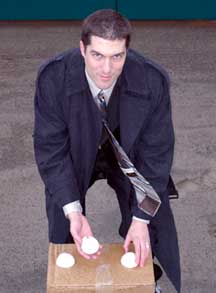Author’s Photo
People have asked for more on the process of getting the book published, so that’s what I’m doing today. The tale of that photo in the upper-right, and what ended up in the book, is funny and offers the opportunity to mock me, which is always good. Keep in mind these are all almost thumbnail, heavily compressed versions of the actual photos, and look even worse than the originals.
Usually, the publisher has someone local they work with. Not in Seattle, though, so for the advance copies and the Houghton-Mifflin catalog, they hit me up for any kind of decent photo. As a result, these feature a headshot of me, taken by my wife when we were in Trafalgar Square.

That works. For a photo to go into the book and so forth, my brother, who’s a fine photographer, took a couple shots while he was up here for a weekend.

I’d hoped I’d get a subtle plug in for a chunk of my book collection*.
There’s the mug-shot style

I’ll spare you the side view. We also did a three-ball monte thing.

and

That second one’s taken on a baseball diamond at home plate, for veracity’s sake.
The publisher didn’t like those, and wanted something more like a traditional headshot. And, because it was publishing, I didn’t hear back on that first batch for a while and ended up needing to produce a suitable set within days. I’ll talk about that whole part of the publishing experience later. I went to the guy who did a frankly awesome job on my wedding. I discovered that my really short hair shows a lot of scalp under studio lighting, but I didn’t have time to grow it out. Also, uh, my face is… anyway. We submitted four photos:
“I’m extremely difficult to photograph for a variety of embarrassing reasons”

Then there’s the friendly, “Do you like my book?”

The “I’m Bill Simmons’ long-lost younger, Germanic brother from a different mother”:

And the one I’ve got in my blogger profile:

I would bet you can guess which of those four the publisher decided was clearly the best, and will be on the back cover of the book.
*Top Shelf: Cobb, a biography, The New Biographical History of Baseball, The Worst Baseball Pitchers of All Time, Me and the Spitter, Bill James Historical Baseball Abstract, Baseball and Billions, The Hidden Language of Baseball, Rob Neyer’s Big Book of Baseball Lineups, Rob Neyer’s Big Book of Baseball Blunders, Baseball Dynasties, Baseball Signs and Plays, Saving the Pitcher, Baseball Between the Numbers, McGraw of the Giants, The Rules and Lore of Baseball, Curve Ball, The New Bill James Historical Baseball Abstract, Out of Left Field, Triumph and Tragedy, Spitters, Beanballs, and the Incredible Shrinking Strike Zone, 9 Innings, A Mencken Chrestomathy, the New Complete Joy of Home Brewing, the Thin Man, Houdini on Magic, The Big Knockover. Head shelf: Total Baseball, BP99-06, Ball Four (on top: Pool and Billiards), my head, Forging Genius, Weaver on Strategy, Wild, High, and Tight, Paths to Glory, Neyer/James Guide to Pitchers, Juicing the Game, Eight Men Out, Cap Anson 2 & 3, This Ain’t Brain Surgery (on top: ???, Green Cathedrals, Bringing Down the House). Bottom Shelf: The Baseball Encyclopedia, The Complete Armchair Book of Baseball, Moneyball, Dollar Sign on the Muscle, Game of Shadows, Maybe I’ll Pitch Forever, Baseball, Lords of the Realm, The Last Yankee, Tough Calls, How LIfe Imitates the World Series, Baseball: the Writer’s Game, A Great and Glorious Game, You Gotta Have Wa, The Glory of Their Times, How Con Games Work, Caro’s Book of Poker Tells, Winner’s Guide to Texas Hold ‘em, The Theory of Poker, Winning Low Limit Hold ‘em, Super System, Harrington on Hold ‘em vol. 2, Play Poker Like the Pros, (Lederer’s book?), Hold ‘em Poker for Advanced Players, Harrington on Hold ‘em vol. 1 (on top: Brew Chem 101, The Odds, The Big Sleep, Fortune’s Formula, The Intuitionist, Hold ‘em Poker, two Raymond Chandlers.
